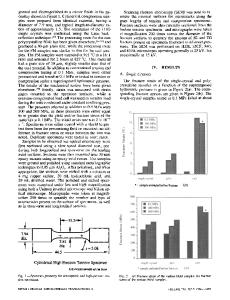Microhardness Anisotropy and the Indentation Size Effect (ISE) on the (100) of Single Crystal NiAl
- PDF / 176,334 Bytes
- 6 Pages / 612 x 792 pts (letter) Page_size
- 28 Downloads / 322 Views
Microhardness Anisotropy and the Indentation Size Effect (ISE) on the (100) of Single Crystal NiAl M.E. Stevenson, M.L. Weaver, R.C. Bradt Department of Metallurgical and Materials Engineering, The University of Alabama, Tuscaloosa, AL 35487-0202, USA
ABSTRACT The Knoop microhardness anisotropy of single crystal NiAl, a B2 intermetallic compound, was investigated on the (001) plane at indentation test loads from 25 to 500 g. An energy balance analysis was applied to analyze the indentation size effect (ISE). The load independent, orientation independent Knoop microhardness was determined to be 220 kg/mm2 for the (100) plane of NiAl.
INTRODUCTION Indentation hardness testing is currently of extensive practical use in evaluating the mechanical properties of intermetallic compounds such as NiAl and other technically significant materials.1 For these analyses a complete understanding of the indentation process is critical to properly interpret hardness data for applications to mechanical and wear properties. Two phenomena that assume important roles during indentation are single crystal anisotropy2 and the indentation size effect, or ISE.3 The microhardness anisotropy has been successfully addressed by comparison to the primary slip system activated in the particular crystal structure. With regards to the ISE, however, a unified theory has not been completely accepted, but rather several different mechanisms for its existence have been advanced. These mechanisms include: friction between the specimen and indenter facets,4 elastic recovery after indentation,5 the load required to initiate plastic flow, work hardening,3 the energy required to nucleate dislocations,5 statistical measurement errors6 and strain gradient plasticity.7 This paper addresses both the microhardness anisotropy and the indentation size effect in single crystal NiAl in terms of a fundamental energy balance, which leads to the prediction of a load independent Knoop microhardness that is also orientation independent on the (100) crystal plane.
EXPERIMENTAL PROCEDURES One nominally stoichiometric NiAl single crystal slab was obtained from General Electric Aircraft Engines, Cincinnati, OH. The dimension of this slab was 25 mm x 32 mm x 100 mm. The slab was homogenized at 1589 K for 1 hour in argon followed by furnace cooling to room temperature. Crystal orientation was determined using the back reflection Laue technique. Single crystal specimens were prepared for microhardness measurements on the (001) crystal plane. Oriented samples were removed from the slab using a diamond saw. After removal, they were epoxy mounted and manually polished through 600 grit silicon carbide. Final polishing was conducted with a 0.06 µm colloidal silica suspension in a vibratory polisher.
N6.4.1
2
Microhardness was measured using an automated testing machine∗ equipped with a Knoop indenter and fitted with a goniometer stage for precise definition of the angular orientations of the test specimen. The Knoop indenter geometry was chosen because it provides a long, shal
Data Loading...











